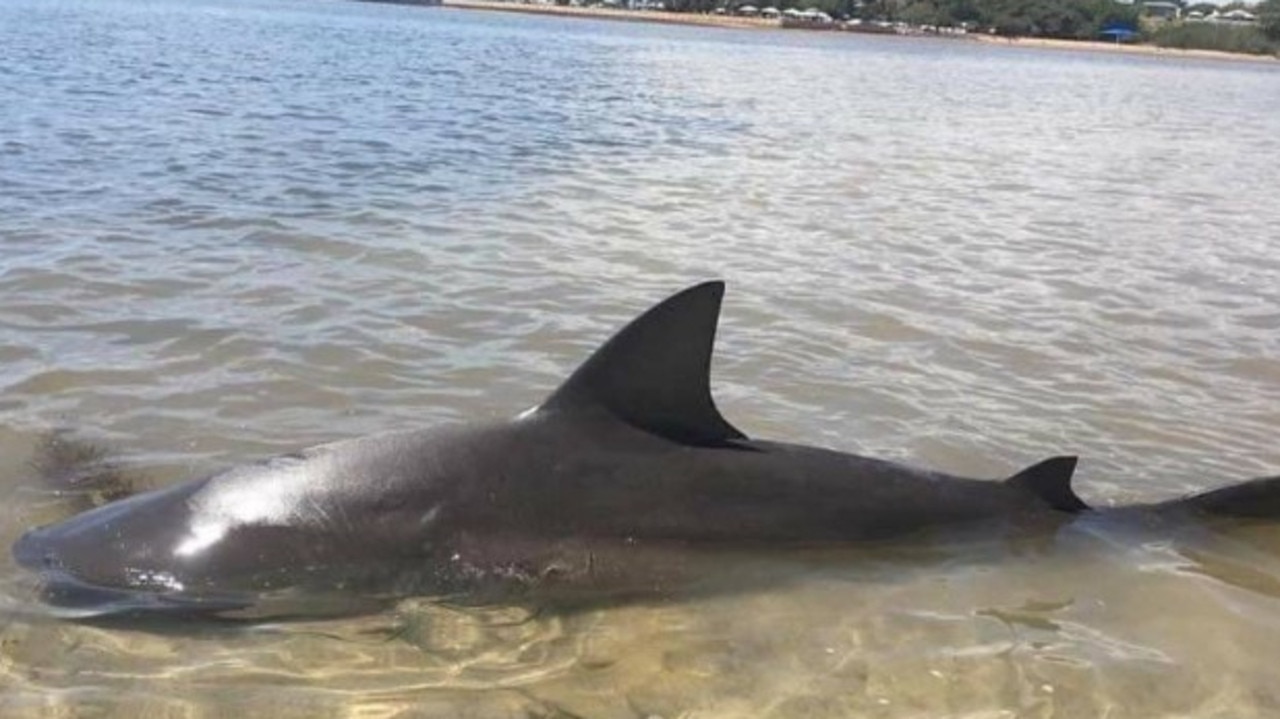Zipline economic benefits may be far lower than we think
The Mt Coot-tha zipline could generate less than half the total economic benefits Brisbane City Council is suggesting. SEE EXTENSIVE Q&A WITH COUNCIL
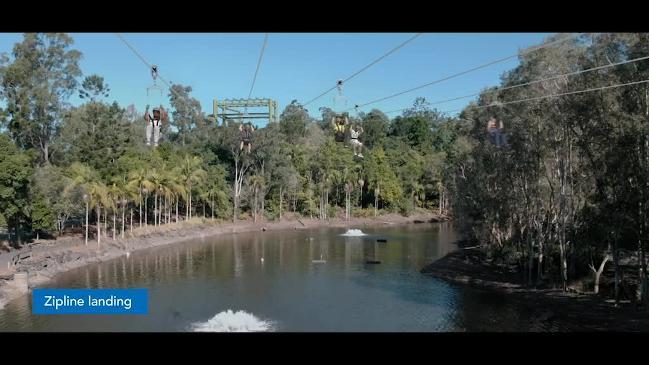
Local
Don't miss out on the headlines from Local. Followed categories will be added to My News.
THE Mt Coot-tha zipline could generate less than half the total economic benefits than Brisbane City Council is suggesting, an economist says.
Helen Jeremy, who has degrees in economics, econometrics and applied finance, said: “The council has picked the largest number on the page to quote.’’
The $232 million (30-year) figure often quoted by council was inflated by a $66 million “existence benefit’’ (the benefit residents would feel from merely knowing the zipline exists), she said.
“The inclusion of an existence benefit inflates the value of the project; it is not actual money injected into the economy,’’ Ms Jeremy said.
Council will feel ratepayers’ wrath over Mt Coot-tha zipline
‘Castle Hill Experience’ must go ahead after federal funding announcement
Zipline tourist numbers same as Uluru, Skyrail
The claims came as opponents lodged a Planning and Environment Court appeal last week.
But Council said it stood by its economic figures and was confident of defeating the appeal, saying its development application (DA) had been comprehensive.
The Mt Coot-tha Protection Alliance submitted the 16-page appeal to the court.
The appeal is likely to delay the project by at least two years.
$1 FOR 28 DAYS: SUBSCRIBE TO WESTSIDE NEWS & THE COURIER MAIL
A council spokesman confirmed it would defend the matter.
“As part of the (DA), Council submitted 17 ecological reports prepared by expert external consultants totalling more than3000 pages,” the spokesman said.
“Due to the extensive work undertaken, Council is confident all potential impacts including environmental, visual, heritage and traffic, were considered and properly addressed.”
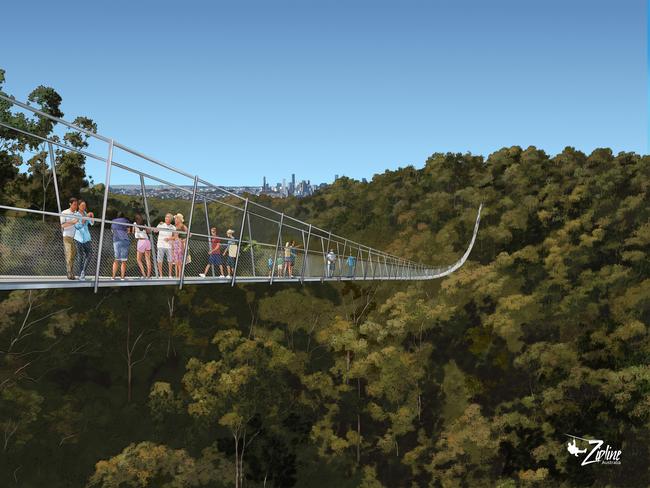
Ms Jeremy said council had quoted numbers calculated at a very low “discount rate’’ (a way of converting future payments into a single value).
“Using a more realistic discount rate and excluding the existence benefit would see the total benefits fall to about $100 million over 30 years,” she said.
Total costs over 30 years were estimated in council’s own DA at $120 million, slashing the project’s “net present value’’ (NPV) to $112 million, assuming a 4 per cent discount rate.
She said when the existence benefit was excluded, the project’s NPV would be just $46 million over 30 years, after costs.
At a more realistic discount rate of at least 9 per cent, the NPV was $22 million over the 30 years.
Ms Jeremy said the DA noted that project operator Zipline Australia’s estimates of capital/operational costs, visitor numbers and spending had not been verified in any detail.
“It is therefore important to acknowledge that the inputs could be overly optimistic and to consider an alternative scenario in the DA,’’ she said.
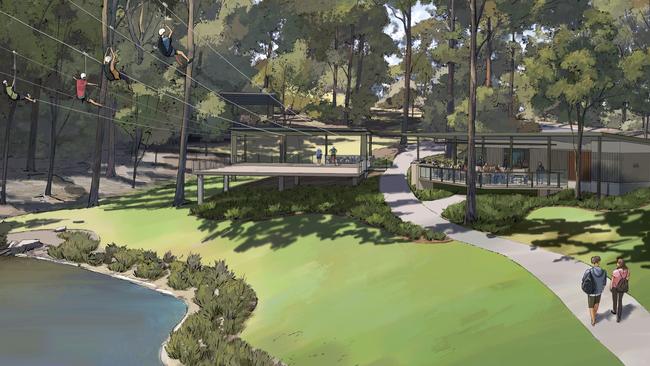
For instance, if costs rose by just 10 per cent, and visitation was only 20 per cent lower than forecast, the project could have an NPV of only about $4 million.
The council spokesman said the $120 million in costs did not “take away’’ from the benefits gained.
“Claims predicted economic benefits have been “artificially” inflated are firmly rejected,’’ he said.
“The cost-benefit assessment of the project was based on conservative economic appraisals, costs and visitation.’’
It was analysed in accordance with the State Government project assurance framework.
Benefits to the community included increased awareness of indigenous history and appreciation of the natural environment.
Even a 10 per cent rise in costs and 20 per cent fewer visitors would result in $132 million in total benefits.
“Under these assumptions, the discount rate would change from 60 per cent to 47 per cent before costs would outweigh the benefits,’’ he said.
At a 9 per cent discount rate, $1.80 would be returned for each dollar spent.

EVERYTHING YOU NEED TO KNOW ABOUT THE ZIP LINE
Many questions: Westside News and The Courier-Mail gave Council a detailed list of questions about the project’s economics. Here is their response:
Q What is the exact role of Zipline Australia in each of the three stages of the project, considering the DA describes the Council as the applicant, and also refers to council as the proponent, and has so far paid for the DA?
A The Mt Coot-tha Zipline is a Council project that is part of a wider $15 million investment into the Mt Coot-tha precinct. Zipline Australia was chosen following a competitive and rigorous tender process to build, own, operate and maintain the Mt Coot-tha Zipline.
Q The DA refers to ZA as a lessee. Is that the full extent of its role, and therefore is Council the owner?
A Zipline Australia will be responsible for the construction, operation and maintenance of the Mt Coot-tha Zipline. Council is the trustee of the land (under a Deed of Grant in Trust) and, subject to State Ministerial approval, Council will enter into a lease with Zipline Australia for a term of 20 years.
Q How is the council’s expenditure of $2M on the DA being treated? As an investment in ZA, as a loan to ZA, as a gift to ZA or none of these?
A Zipline Australia was not an applicant for the Mt Coot-tha Zipline development application. Any claims that Council provided money to Zipline Australia for the development assessment process are firmly rejected.
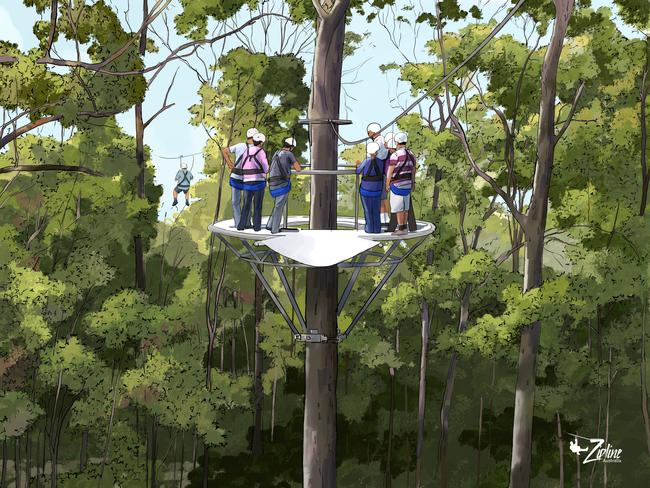
Q Which corporate entity (BCC, ZA or someone else) will ultimately pay for - and own - the on-ground assets? Or will the three stages of the project be shared by ZA and BCC?
A Zipline Australia will be financially responsible for the construction, operation and maintenance of the Mt Coot-tha Zipline, subject to the lease terms.
Q There will be many contracts awarded for the detailed design, manufacture and construction of various components of the project. Who will sign these contracts and who will make the payments (ie write the cheques) to the various contractors? Will this be ZA or BCC, or both, or some other entity
A Zipline Australia will be responsible for managing, procuring and paying any contractors that may be required for the construction, operation and maintenance of the Mt Coot-tha Zipline.
Q Who will be the Principal Contractor for the purposes of Qld WH&S Legislation and, therefore, who will bear liability for any injuries/deaths (Council, or ZA, or both)?
A The Mt Coot-tha Zipline operator will be responsible for Queensland Workplace Health & Safety requirements. Legal liability will apply to the operator in the event of accidents or incidents, unless otherwise exempted under Queensland law.
Q Who is taking the financial risk on the success or failure of the project? That is, if there is an operating loss, will Council bear full or partial responsibility for this, and if there is a profit, who will bank the profit (Council, or ZA, or both)
A Zipline Australia will be responsible for the construction, operation and maintenance of the Mt Coot-tha Zipline.
Q How much more money (over and above the approx $2M already spent) is BCC going to directly spend on the design, construction, operation and maintenance of the on-ground assets, and for what purposes?
A Council will contribute $1 million towards the construction of the Mt Coot-tha Zipline.
Q To what extent will BCC be an investor (by providing debt or equity funding) in the project?
A Council will contribute $1 million towards the construction of the Mt Coot-tha Zipline. Council is not providing debt or equity funding in the project.
Q If ZA intends to borrow money to fund the project, will BCC provide any loan guarantees?
A No.
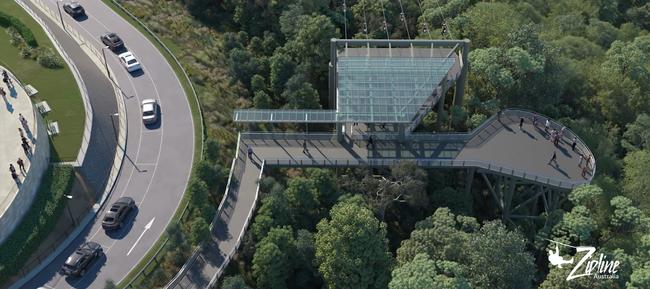
Q Council said in a recent press release: “Family-owned Brisbane company Zipline Australia had been selected by Council to design, build, operate and maintain the zipline.’’
Is this still the case, as it implies no financial input by Council and no public liability exposure from any injuries/death to Council?
A Zipline Australia will be responsible for the construction, operation and maintenance of the Mt Coot-tha Zipline. Legal liability will apply to the operator in the event of accidents or incidents, unless otherwise exempted under Queensland law. Council will contribute $1 million towards the construction of the Mt Coot-tha Zipline.
Q BCC says there will be economic benefits of $232 million over 30 years, however the costs are $120 million, so net benefits would be $112 million, according to the DA. Why has council not spelled this out in its various communications with residents (letterbox flyers, press releases etc)?
A The total benefits of the Mt Coot-tha Zipline are valued at $232 million over a period of 30 years. The direct cost of the Mt Coot-tha Zipline project is estimated at $120 million, including construction, maintenance and the delivery of associated infrastructure. These costs do not “take away” from the benefits gained.
Q Why did Council include an existence benefit of $66 million, given its exclusion means the project is only really worth $46 million over 30 years in the best case scenario (4% discount rate). How did council/its consultant who wrote the economics case, come up with the $66m figure?
A Any claims that predicted economic benefits have been “artificially” inflated are firmly rejected. The cost benefit assessment of the Mt Coot-tha Zipline project was based on conservative economic appraisals, costs and visitation to the ecotourism attraction. This assessment focused on costs and benefits to the community, such as increased awareness of indigenous history, safety improvements and an improved understanding and appreciation of the natural environment.
Q Economists (and Infrastructure Australia guidelines) say a more realistic discount rate is 9%, meaning the net benefit of the project would be only $22 million over 30 years.
Why has council/its economics consultant chosen a 4% rate, which is on the low side of average (in most commercial announcements to the market discount rates must be conservative and as accurate as possible).
A The estimated economic benefits of the Mt Coot-tha Zipline are considered conservative. Sensitivity testing was modelled with discount rates of 4 per cent, 6 per cent and 9 per cent, which showed robust returns of $1.92, $1.87 and $1.80 respectively for every dollar spent on the Mt Coot-tha Zipline project. The discount rate would need to rise above 60 per cent before the costs would outweigh the benefits.
Q If costs increase by 10%, and there is 20% less visitation, (a scenario provided in the DA economic report), then the net benefit of the project could be as low as $4 million over 30 years.
Why has council not communicated this with residents in its flyers/press releases etc and instead opted to quote only the highest estimates in the DA?
A This scenario is broken down in detail in the economic benefits report uploaded to PDOnline. At a 10 per cent increase in cost and 20 per cent less visitation, the total project benefits would be $132 million with a $1.53 for every dollar spent. Under these assumptions, the discount rate would change from 60 per cent to 47 per cent before costs would outweigh the benefits.
Q Is it the case that the reliability of the economic reports is called into question by lack of verification of inputs
A The estimated economic benefits of the Mt Coot-tha Zipline project were analysed in accordance with the Queensland Government’s Project Assurance Framework and are considered conservative. Where secondary sources of information or assumptions were required, this has been clearly noted in the report.
Q Is the reliability of the economic reports called into question by the fact they are a “qualified assessment” which relies on inputs provided by Zipline Australia, with no independent assessment of ZA’s forecasted visitor numbers and costs.
A The estimated economic benefits of the Mt Coot-tha Zipline project were analysed in accordance with the Queensland Government’s Project Assurance Framework and are considered conservative. Where secondary sources of information or assumptions were required, this has been clearly noted in the report.
Q Is the reliability of the economic reports called into question by lack of details of the capital expenditure, maintenance items and their timing throughout the project.There is also no copy of the quantity surveyor’s report.
A The estimated economic benefits of the Mt Coot-tha Zipline are based on the costs and benefits to the Brisbane community, rather than the costs and benefits to an operator or organisation.
Q Is the reliability of the economic reports called into question by the effects of adverse weather condition on visitor numbers.
A Adverse weather effects are one of the variables built into the financial models and forecasts for the Mt Coot-tha Zipline project.
Q Why is there no comprehensive tourism study
A There has been detailed research conducted into the opportunities and challenges. This includes research completed in 2018 by Brisbane Marketing that indicates Brisbane is currently losing $1.5 billion per annum in visitor expenditure due to a lack of nature-based and adventure experiences. The Mt Coot-tha Zipline project is expected to encourage an additional 40 per cent in visitation.
Q Why is there no identified product market given that similar experiences are available elsewhere. There is no feasibility assessment profiling target markets, estimating market sector penetration, patronage projections, etc, to demonstrate viability. Research shows patronage numbers decline after first year.
A Zipline Australia provided estimates for visitation, visitor spending and development costs as part of their proposal to Council. The estimates for the average annual patronage rates by year three of operations will be approximately 348,000 in total for all three zipline experiences. It is estimated that 60 per cent of visits will be domestic, 25 per cent will be by South East Queensland residents and 15 per cent international.
These forecasts are broken down as:
Scenic Zipline – 120,000 per year
Treetop Canopy Tour – 35,000 per year
Skywalk – 193,000 per year.
These estimates reference potential five per cent annual increases, as noted in the Economic and Social Impact Report uploaded to PDOnline, however, this growth is not essential to make the project viable.
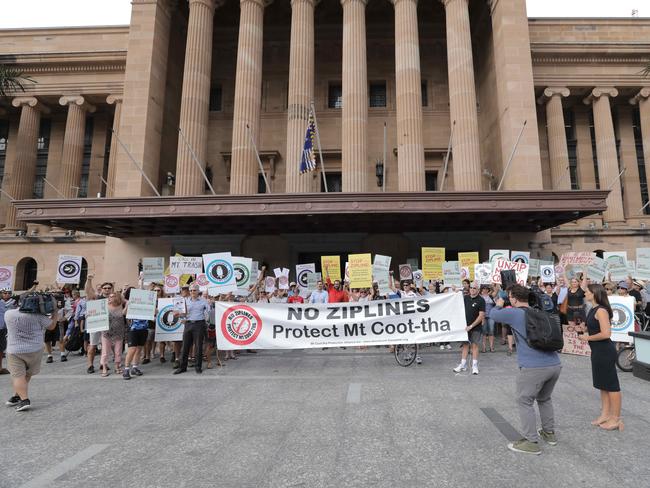
Q The forecast patron profile is different to that of similar projects. Does this call into question the increased demand for tourism accommodation.
A Comparing target audience profiles is overly simplistic and is not an accurate analysis. Brisbane has its own unique opportunities and potential target audiences, which includes the types of people and reasons why they visit our city. Brisbane is currently losing $1.5 billion per annum in visitor expenditure due to a lack of nature-based and adventure experiences and the Mt Coot-tha Zipline project is expected to encourage an additional 40 per cent in visitation.
Q Why is there no consideration that the project could have negative impacts on tourism numbers to the botanic gardens and the forest. The assessment has assumed that 80 per cent of people in Brisbane city would value the existence of this “eco-tourism attraction” and would be theoretically willing to pay $5 per annum just because it exists.
A Council undertook internal feasibility studies prior to going to tender, reviewing comparable offerings in Australia and across the world. It was considered there would be no negative impacts to the existing attractions on Mt Coot-tha or to the people who currently use these facilities. Further, it is identified that the Mt Coot-tha Zipline project will enhance the area due to a range of benefits including increased exposure the area’s indigenous history, understanding and appreciation of the natural environment, and additional excursion opportunities for school students.
Q Why is there no consideration of the project not being economically viable
A This claim is firmly rejected. Council considered whether the project would be economically viable during the initial feasibility study, prior to the Request for Tender process. This scenario has also been considered as part of the sensitivity testing completed within the economic benefits report which shows that the discount rate would need to rise to over 60 per cent before the costs would outweigh the benefits.
Q Why is there no consideration of where the financial responsibility for removing infrastructure and making good if the project is not economically viable. I am seeking a response to this, and why these points were not addressed in the DA.
A Factors such as “making good” are accounted for in feasibility assessments undertaken by Zipline Australia. The economic report details the costs and benefits to the Brisbane community, rather than the costs and benefits to an operator or organisation.
Any potential costs to remove infrastructure and make good obligations will not be borne by Council.
Q Can council confirm if it will subsidise the project if it is not operationally sustainable?
A Zipline Australia will be responsible for the construction, operation and maintenance of the Mt Coot-tha Zipline. Council will contribute $1 million towards the construction of the Mt Coot-tha Zipline as part of a $15 million investment into the Mt Coot-tha precinct.


